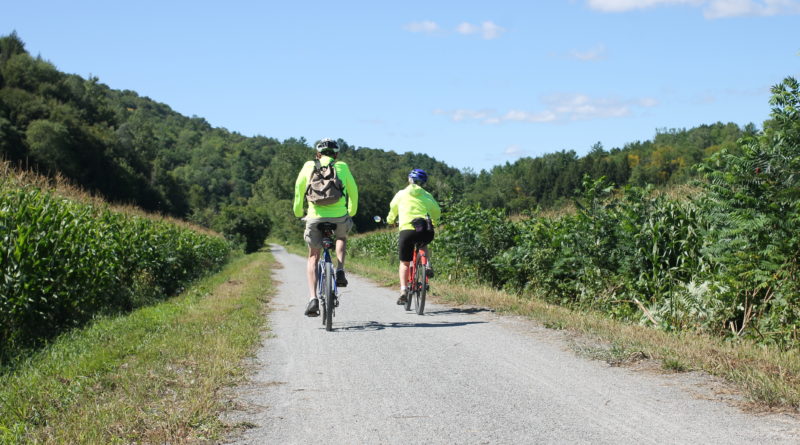Vermont’s Newest Rail Trail
With more than $14 million in funding recently approved for the Lamoille Valley Rail Trail, it won’t be long before you can ride from St. Johnsbury to Swanton. Here’s a taste of what’s to come.
O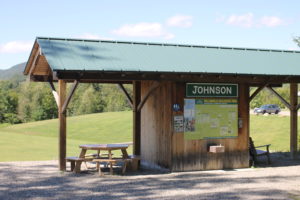 n August 12, funding for one of the biggest new trail projects in Vermont was approved by the Legislature: $14,150,000 to complete the Lamoille Valley Rail Trail, with Vermont paying $2,830,000 and the federal government paying $11,320,000.
n August 12, funding for one of the biggest new trail projects in Vermont was approved by the Legislature: $14,150,000 to complete the Lamoille Valley Rail Trail, with Vermont paying $2,830,000 and the federal government paying $11,320,000.
At present, two sections of the trail are open and mapped: St. Johnsbury to Danville and Morristown to Jeffersonville. Starting at the southern terminus in St. Johnsbury, you can currently ride 14 miles to Danville, take a dip there in Joe’s Pond and then ride back. The next section of trail, when completed, will let you continue northwest from Joe’s Pond veering away from well-traveled roads up to the quiet town of East Greensboro before following Routes 16 and 15 back toward Hardwick and on to Morristown.
The most popular section of trail, Morristown to Jeffersonville, was completed in 2015 and already sees an estimated 20,000 riders a year. Two smaller sections, 5 miles from Swanton to Highgate and 5 miles from Highgate to Sheldon will be finished late this fall or early winter.
The construction from Swanton to Highgate began August 31st, and the section from Highgate to Sheldon will begin two to three weeks after. Bids will go out to finish the bigger sections next summer: 15.7 miles from Danville to Hardwick, 11.5 miles from Hardwick to Morrisville, and 18.5 miles from Cambridge to Sheldon.
Once completed, the trail will total 93 miles from St. Johnsbury to Swanton. Even more exciting is the prospect of linking the Lamoille Valley Rail Trail with the Missisquoi Valley Rail Trail at Sheldon Junction.
This means you could eventually ride 18 miles from Sheldon Junction to Richford on the Canadian border. Or, head south on the Missisquoi Trail and ride 13 miles from the intersection to St. Albans and Lake Champlain.
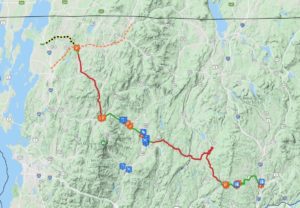 And recently the Missisquoi Valley Rail Trail was awarded a state grant to install three new trailhead kiosks and upgrade two others with repair pumps, better signage and directions to connect to Quebec’s Route Verte (it’s own massive trail system) when the border opens.
And recently the Missisquoi Valley Rail Trail was awarded a state grant to install three new trailhead kiosks and upgrade two others with repair pumps, better signage and directions to connect to Quebec’s Route Verte (it’s own massive trail system) when the border opens.
The $64,417 grant was one of seven awarded by the Vermont Outdoor Recreation Economic Collaborative for 2020.
THE ROUTE NOW
To get a taste of what is to come, I set out in late August to ride one of the completed LVRT sections, between Jeffersonville and Morrisville—and back. The Jefferson stop has about 15 parking spaces and room for overflow if need be. Where the trail currently ends, the train tracks are gone and there are grass medians between two pathways. Off-road bikers and runners could manage it, but it’s best to stick to the finished trail. Soon the grass and small rocks will be replaced with crushed stone for a firm and stable surface that’s compliant with the American Disabilities Act.
As of now, the finished parts of the trail are suitable for biking, running, cross-country skiing, horseback riding, snowshoeing, and snowmobiling. The trail is also so buffed that you could take strollers and wheelchairs along it. Although there are some small paved sections, it is primarily all off-road.
On a late August day, I took my all-terrain Raleigh Talus 3.0 I and set off on a 40-mile tour of rural Vermont. The trail here follows the Lamoille River Valley, with gentle grades, passing meadows of wildflowers and corn, dairy farms and stands of woodlands.
The trail passes near Jeffersonville, Johnson and Hyde Park and then to the center of Morrisville: each with trailheads with a kiosk, bathrooms, maps, bike pumps and water fountains, as well as parking. The stops for Johnson and Hyde Park are about a quarter mile outside of the downtown districts, each having coffee shops, restaurants and shops for trail participants to stop in.
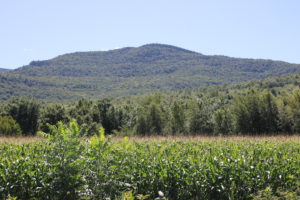 In Johnson, you can fuel up for the ride at Mudgie’s Food Truck for a chicken sandwich served with a homemade pickle or stop in at Johnson Hardware to pick up just about anything you can imagine, from Patagonia apparel to Hyrdroflask water bottles. Johnson is also home to Lamoille Valley Bike Tours, which offers Vermonters 10 percent off on pedal-assist e-bike rentals ($35 for two hours), which can be used on the trail. Yva Rose, owner of Lamoille Valley Bike Tours, grew up in nearby Wolcott and has seen her business boom with the rise of rail trail traffic. She and her husband also offer tours. When I asked for an insider tip, she raves about the new café, Fork and Gavel, in Hyde Park.
In Johnson, you can fuel up for the ride at Mudgie’s Food Truck for a chicken sandwich served with a homemade pickle or stop in at Johnson Hardware to pick up just about anything you can imagine, from Patagonia apparel to Hyrdroflask water bottles. Johnson is also home to Lamoille Valley Bike Tours, which offers Vermonters 10 percent off on pedal-assist e-bike rentals ($35 for two hours), which can be used on the trail. Yva Rose, owner of Lamoille Valley Bike Tours, grew up in nearby Wolcott and has seen her business boom with the rise of rail trail traffic. She and her husband also offer tours. When I asked for an insider tip, she raves about the new café, Fork and Gavel, in Hyde Park.
“They’re a great new café, and oh man, their waffle fries are really good and their avocado toast, I could rave on an on,” she said.
As I rode east, I could see the peaks of Green Mountains rising on the horizon. Close to the Johnson stop, I went through fields of high cornstalks and dense forests. As I paralleled the path the Lamoille had cut through rocks and mountains, I felt like I was witnessing history of past glaciers slowly moving through the Vermont landscape. I stopped my bike to run my hand along the massive boulders and found spiders, beetles and other insects fixing their small nooks or wandering along the rock.
Within a mile of the cornstalks and forests, I crossed one of the many old rail bridges that spans a section of the Lamoille River and made another stop. Two paddlers passed under the bridge in kayaks. The river weaves along the majority of the trail, sometimes even crossing over it. Certain points are safe to venture down from the path and take a dip into the refreshing water to wash some sweat off or to take a break from the heat. The riverbed is mostly sand, but some parts have more dirt and muck than others. Yva Rose also told me about some great swimming holes, such as Dog’s Head Falls, Beard Park (both in Johnson) and Brewster River Swimming Hole in Jeffersonville.
A 93-MILE ADVENTURE
As I rode, east I could imagine starting at the southern end of the trail in St. Johnsbury and working my way back, perhaps camping along the way or stopping to refuel or spend the night at small towns along the way: Jeffersonville, Johnson, Morrisville, Hyde Park, Danville, St. Johnsbury, Sheldon.
For those looking to camp, Sugar Ridge RV Park and Campground, a private campground in Danville, offers a place to stay, and approximately four miles from Morrisville is Elmore State Park. Riders wanting to venture farther from the trail can go to the Vermont Campground Association’s website and use their interactive map to find campsites.
Once I arrived in Morrisville, I was hit with the smells of fresh beer and grilling —I couldn’t resist. Just off the trail is a staircase that leads to the Lost Nation Brewery. A red building with hops running up the side is home to the brewery where riders and walkers can stop to get a pilsner, ale or IPA and a sandwich, hot dog or appetizers to fuel up for the rest of the route. Hank Glowiak, the owner of Chuck’s Bikes in Morrisville, recommends the salmon tacos with corn relish. Chuck’s Bikes rents hybrid bikes with around a 35-centimeter tire width, but most sizes are ridable on the trail. These bikes go for $20 for the day. PowerPlay Sports, also in Morrisville, has both mountain bikes and hybrids for rent as well.
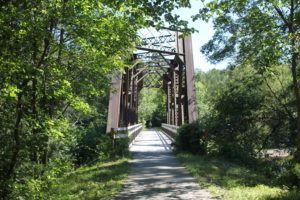 In Morrisville, just past bustling Portland Street is an old rail station that was transformed into the restaurant, 10 Railroad Street. The service station is the old ticket booth and the dining room sits on the station’s platform. There you can order 12 craft beers on tap, wine, martinis and pub food. The go-to menu item for rail trail riders is the turkey BLAT, which comes with roasted turkey breast, lettuce, tomato, bacon, avocado, maple cider mayonnaise, on a toasted wheat bread with a side of fries. The restaurant reopened on September 4th after internal repairs.
In Morrisville, just past bustling Portland Street is an old rail station that was transformed into the restaurant, 10 Railroad Street. The service station is the old ticket booth and the dining room sits on the station’s platform. There you can order 12 craft beers on tap, wine, martinis and pub food. The go-to menu item for rail trail riders is the turkey BLAT, which comes with roasted turkey breast, lettuce, tomato, bacon, avocado, maple cider mayonnaise, on a toasted wheat bread with a side of fries. The restaurant reopened on September 4th after internal repairs.
The building itself harkens back to the days when the railroad was one of the few east-west lines to carry passengers and freight across the state. Before the Lamoille Valley Railroad, was constructed, the interstate system focused on transportation from north to south. In 1867, an interest took hold and construction began on the line. It started off catering to passengers, but with the invention of the automobile, demand hit a steady decline. The railroad went through a rough history—flooding damaged parts of the line many times—and the company went into bankruptcy as demand plummeted.
With demand low and the invention of the refrigerated car, the market moved to transporting milk. But soon the railroad went under and declared bankruptcy. After private ownership bought the rail but could not keep it afloat. The state bought it back and trains continued to run, although sporadically, through the 1980s.
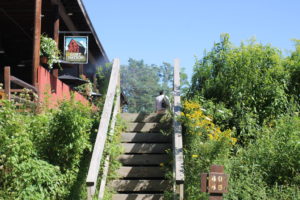 In 1994, the railroad ceased all operations and in 1997, the Vermont Association for Snow Travelers (VAST) formed a committee to construct a multi-use recreation trail in response to the State’s request for proposals.
In 1994, the railroad ceased all operations and in 1997, the Vermont Association for Snow Travelers (VAST) formed a committee to construct a multi-use recreation trail in response to the State’s request for proposals.
According to Sue Scribner, the Municipal Assistance Bureau Director of Vermont Agency of Transportation, the line was “rail banked” in 2004. Rail banking is an agreement between the owners of the railroad company and a trail agency to use a rail corridor as a recreation trail until rail service is needed again.
In 2005, then-Congressman Bernie Sanders secured an earmark for the trail and the federal government matched 20 percent of the funds. To date, $8.7 million has been spent on the trail, and the $14.4 million will, by current estimates, complete it. Ken Brown, the LVRT Project Manager, says the cost includes the planning and engineering, repairing seven bridges that were destroyed or damaged, repairing structures, drainage infrastructure and surface material. Per mile, it costs $150,000 to complete.
Although the cost seems high, there is direct evidence of economic growth in places where the trail was built. “One example,” Scribner says “is Lost Nation Brewery. A large amount of their foot traffic coming in and enjoying their facility is coming off the rail trail.”
At 10 Railroad Street, a restaurant directly off the trail in Morrisville, the general manager Andy Figliola, has seen about a 25 percent increase in business since the opening of the trail. 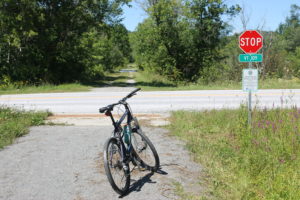
“People come in from biking the trail in summer and foliage season and in winter, snowmobile traffic is really big,” he said.
As I rode back, I regretted not coming to the trail earlier in the summer. However, I’m already gearing up for round two, and am counting down the days until 2022 when the entire path is finished.

